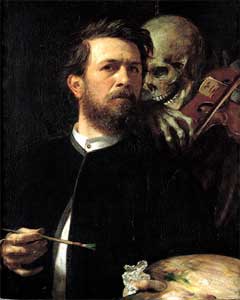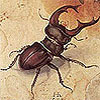|
усднфмхйх
тнрнцпютш
ймхцх Х юркюяш
яхярелю фхбнцн
лхпю Б
хккчярпюжхъу
хгдюрекэярбн
люярепяйюъ
онкегмше
яяшкйх |
Boecklin, Arnold
Arnold Boecklin
Boeklin,
Arnold
Arnold Boeklin
Böcklin,
Arnold
Arnold Böcklin
аЕЙКХМ, юПМНКЭД
юПМНКЭД аЕЙКХМ
(1827 - 1901)

Self-Portrait with Death as a Fiddler, 1871-74.
Oil on canvas, 75 x 61 cm. Nationalgalerie, Berlin
оЕПЕИРХ Б юПР-ЦЮКЕПЕЧ Arnold Boecklin
Biography
|
Arnold Böcklin was born in Basel on October 16,
1827 as the son of a salesman and the wealthy daughter of an old Basel family.
Having attended secondary school, which he left in 1845 because of his great
talent in drawing, Arnold Böcklin went to the art academy in Düsseldorf. There,
Böcklin became a student of Johann Wilhelm Schirmer, who was dedicated to the
classicist dramatic style of landscape painting. During this training, Arnold
Böcklin regarded himself totally as a landscape painter. When he traveled to
France, he witnessed the events of the February revolution in 1848 and the
bloody workers revolts of June 1849, which he depicted in a shocked manner
considering his middle class upbringing. Before Böcklin traveled to Italy in
1850, he finished his studies in Basel under the Alpine landscape painter
Alexandre Calame. In Italy Arnold Böcklin met Anselm Feuerbach. At the same time
he was influenced by Italy's landscape - the sea, the landscapes flooded with
sunlight and the cypress trees kept reappearing in Böcklin's later work. Another
influence on Arnold Böcklin's future work was exercised by Heinrich Dreber and
his mythological figures in mysterious landscapes. In 1853 Böcklin married
Angela Pascucci, with whom he had 4 children. As the family's financial
situation was not good, Böcklin decided to return to Germany, where he received
first orders in 1858 in Hanover and Basel. The family temporarily lived in
Munich, where Arnold Böcklin and his two children contracted typhoid fever.
Böcklin's financial situation only improved, when he accepted a 2 years'
teaching position at the Weimar art school in 1860 and executed his first big
commission for the Basel museum. Arnold Böcklin spent most of the years after
1862 in Italy, where he lived in Rome and Florence and visited Naples and
Pompeii. He was influenced by the Ancient World. His palette became stronger and
brighter, human and semi-human figures became more important and the number of
pure nature studies decreased even more. In spite of some success and some
exhibitions, Arnold Böcklin continued to suffer from financial distress. On May
14, 1892, when he had returned to Florence after two years in Zurich, Arnold
Böcklin had a stroke. In spite of several rehabilitation therapies, the state of
his health was already very worrying during this time. From the mid-90s the
prices for his works rose, in some cases 10- to 20-fold. For nine more years he
painted with help from his son, because he was suffering from other physical
ailments. Arnold Böcklin died in St. Domenico (Italy) on January 16, 1901. link |
оЕПЕИРХ Б юПР-ЦЮКЕПЕЧ Arnold Boecklin
яЯШКЙХ - Links
|
|
